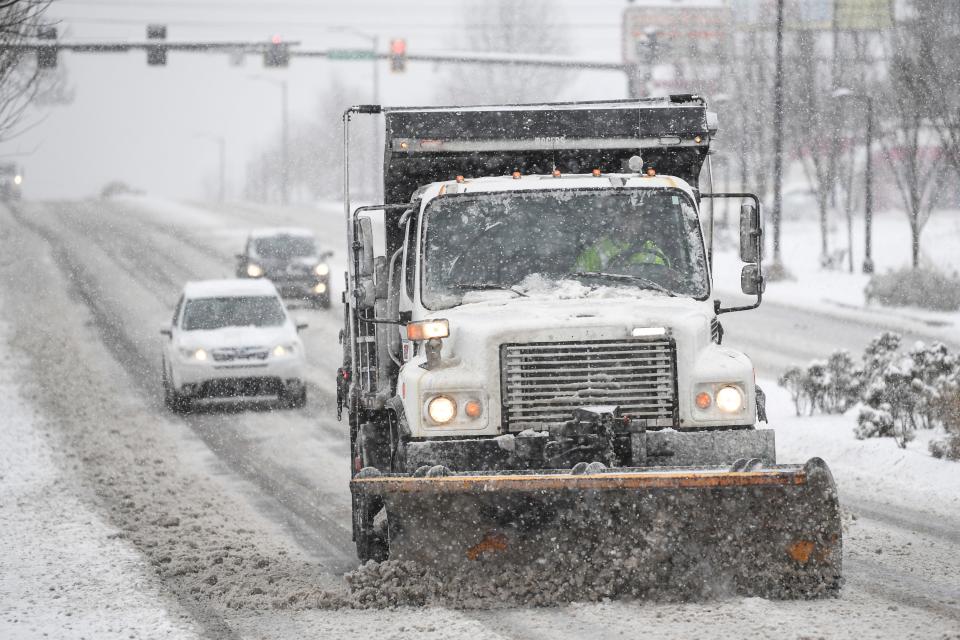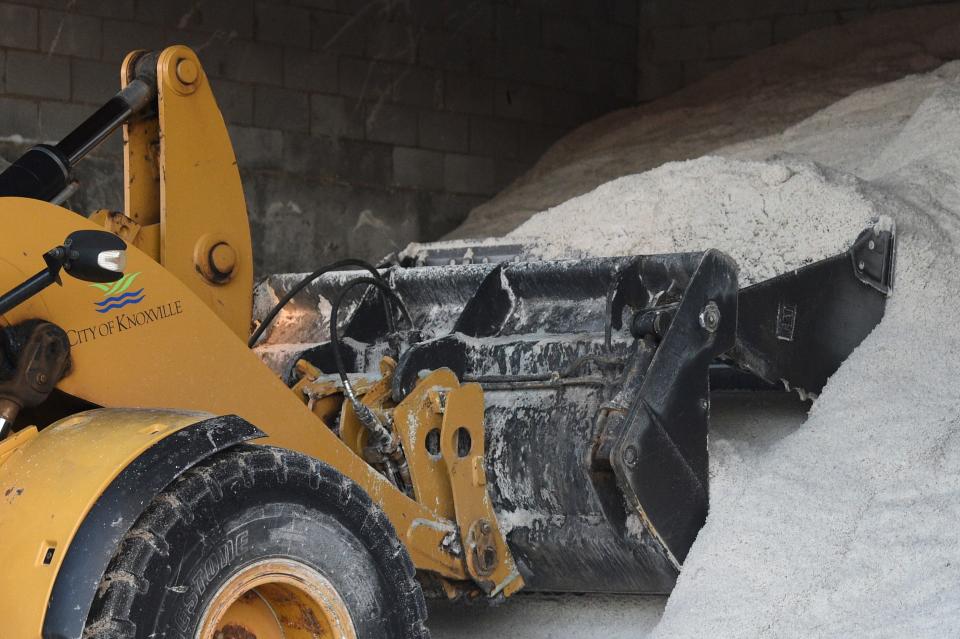Snowiest towns in America share a tip: Snow removal is about managing expectations
Leaders in some of America's snowiest cities say the job of clearing snow and ice includes a critical component that has nothing to do with plow blades on pavement: managing expectations.
In a city like Rochester, Minnesota, which averages about 50 inches of snow a year, 2-inch snowfalls are child's play. But an 8- to 10-inch snowstorm, like Knoxville just got, would be considered a major event.
Jake Busho, street maintenance supervisor for Rochester, told Knox News the city expects to have high-priority roads plowed within 12 hours after a snowfall of 4 inches or more. Neighborhood streets aren't cleared until afterward, and in smaller snows, they may not be plowed at all.
"The expectations are higher than what we can probably truly provide when we are in a big snowstorm event like that," Busho said. "I think everyone expects bare pavement all the time, just because it's such an easy standard."
In a single day, some areas of Knoxville and Knox County got twice as much snow as they would normally get in an entire year. The average annual snowfall in Knoxville is 4.6 inches, according to the National Weather Service, and 6.5 to 10 inches fell on Jan. 15.
For most city and county employees, the storm brought more snow than they've ever had to deal with, and it stuck around all week as temperatures stayed below freezing.
With the storm came a widespread plowing operation that has left some streets, especially residential ones, untouched as people reported being stuck at home.

In Rochester, the city council approves the snow removal plan for 40 pieces of equipment on 500 miles of road. Busho said the city of 121,000-plus people has "quite the arsenal of equipment" that goes into action when a snowstorm arrives.
Like many Northern cities, Rochester tries to limit the amount of salt it uses, both for budget reasons and to reduce environmental impacts.
"There's a lot of different areas that don't get treated just because, you know, the sheer cost and the budget that we have to stay within," Busho said.
When Knoxville began to run out of salt this week, it ordered 1,800 additional tons at $122 a ton for a total of $219,600. That's in addition to the $335,000 the city had spent by midweek on overtime pay and supplies. The full cost of the storm won't be tallied for another week or two.

How one of America's snowiest towns races to clear streets
With 120 inches of snow in an average year, Sault St. Marie (pronounced "Soo St. Marie") is one of the snowiest places in Michigan and in the country. The town hosts the International 500 Snowmobile Race each winter, a 500-mile race on a one-mile track better known as the "Soo I-500."
Kevin Mayer, the town's stockman and timekeeper who manages the public services office, said a handful of plow trucks work night and day to clear the streets.
"Very seldom is a road not plowed" in the town of just over 13,000 people on the Canadian border, Mayer told Knox News.
Still, snow gets packed down hard on residential streets and even if most residents have lived there most their lives, they have ideas about how plowing ought to be done.
“You got pros in every category that think they know how it's supposed to be done properly, and none of them have ever stepped foot in a plow truck," Mayer said.
Towns like Sault St. Marie and Rochester might revise their snow removal plans based on how each year's snowstorm events unfold.
Knoxville is no different. The city and county will both take this week's events into consideration as officials modify their snow removal plans this year.
Jim Snowden, chief engineer for Knox County Engineering and Public Works, said this past week's snow is more than he's ever seen in 25 years with the county.
“Obviously, any time you have an event like this, you want to debrief on it,” Snowden said. “We want to provide the best possible services to the taxpayers.”
As it does every year, the city of Knoxville will conduct a "thorough review based on the last year’s snowstorms, trends of snowstorms, and what streets were trouble spots that resisted being treated," said Eric Vreeland, a city spokesman.
For Knoxville, a question of practicality
The city of Grand Rapids, Michigan, is a similar size to Knoxville, but it gets 76-78 inches of snow each year. Since Jan. 12, the city has gotten 30 inches of snow in steady blankets each day.
Grand Rapids is more than equipped to meet the demand, said John Gorney, public works director. With about 45 plow trucks and 30 pickup trucks outfitted with plows, Grand Rapids tries to be finished plowing 24 hours after a snowfall.
The city has offered snow plow ride-alongs to local media and elected officials, who are then better able to address the public's concerns.
“There's a lot going on in the truck,” Gorney said. “You’re trying to watch out for pedestrians and other vehicles and trash cans and mailboxes and still do your job and do it well. So I don't know that people understand all of that.”
As a state leader with the American Public Works Association, Gorney has traveled around the country talking with city officials about snow. He said Knoxville probably doesn't need to beef up its fleet of snow plows. The city has about 24 plows and Knox County has 24 vehicles with plowing capability.
“If it's not something that you get on a regular basis, you don't plan for it, nor should you have to, because it's hundreds of thousands of dollars," Gorney said. “I don't necessarily know that you'd want to spend all that extra money to be prepared for something that doesn't happen that often.”
Knox County, with more than 1,800 miles of roads, will look into expanding its fleet, Snowden, the chief engineer, said.
“Over 30 years, is it cost effective to invest in that? That’s a tough question to answer," Snowden said. "I think we’ll look into that, but I think it would be hard to justify that for such an isolated event.”
Some governments and public agencies enlist a largely contracted workforce to clear snow, like RTD, an agency that provides public transportation to over 3 million people in the Denver area.
“Here in Colorado, I think people realize more because of how much snow we get that it is a process, and you can't continually just get all the snow up," said Tom Garza, RTD's facilities maintenance manager. "You have to work through a route and then work back.”
RTD has reason to be proud of its own staff since two members are repeat first-place winners in the National Snow Roadeo, a one-day event that tests the skills of plow drivers and other snow equipment operators.
“It’s celebrated throughout the company,” Garza said.
Newsflash: Every town has struggles with winter driving
One advantage of living in a snowier place is that drivers are more used to navigating slippery roads. In snowy climates, it's more common that people put winter tires on their cars and drive confidently (if carefully) in icy conditions.
As more people move into Colorado from states such as Florida and Texas, Garza said Denver is getting more drivers who are unaccustomed to navigating snow and ice.
Some drivers will break the rules of winter driving, and that's not a problem only in towns like Knoxville, snowy city officials say. Perhaps ironically, residents of even the snowiest cities need to warm up to driving in cold weather.
"It never ceases to amaze us, I guess is probably the best way to put it," Busho, the street maintenance supervisor in Rochester, said. "Seems like everyone always forgets the first couple of snowstorms and then everyone gets settled in."
The difference in Knoxville is that residents may have to wait another 25 years to test their skills again.
Daniel Dassow is a growth and development reporter focused on technology and energy. Phone 423-637-0878. Email daniel.dassow@knoxnews.com.
Support strong local journalism by subscribing at knoxnews.com/subscribe.
This article originally appeared on Knoxville News Sentinel: America's snowiest towns: Snow removal is about managing expectations

